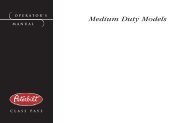Peterbilt Medium Duty Truck Owner's Manual - Peterbilt Motors
Peterbilt Medium Duty Truck Owner's Manual - Peterbilt Motors
Peterbilt Medium Duty Truck Owner's Manual - Peterbilt Motors
You also want an ePaper? Increase the reach of your titles
YUMPU automatically turns print PDFs into web optimized ePapers that Google loves.
Preventive Maintenance<br />
00138a<br />
Underinflation: causes abnormal<br />
tire deflection, which builds<br />
up excessive heat, running the<br />
risk of failure. It also causes<br />
irregular wear.<br />
Overinflation: reduces the<br />
tread contact area with the road<br />
surface, concentrating all of the<br />
vehicle weight on the center of<br />
the tread. This causes premature<br />
wear of the tire.<br />
• Too much air pressure reduces the tire tread contact<br />
area and results in rapid wear in the center of the tire. It<br />
also causes tires to run hard and makes them more vulnerable<br />
to impact and other road hazard damage.<br />
00139a<br />
TREAD<br />
CONTACT WITH ROAD<br />
TREAD CONTACT<br />
WITH ROAD<br />
WARNING! Overinflated tires can cause accidents.<br />
They wear more quickly than properly<br />
inflated tires and are more subject to punctures,<br />
cracks, and other damage. They could fail and<br />
cause you to lose control of your vehicle resulting<br />
in an accident causing death or personal<br />
injury. Be sure all tires are inflated correctly<br />
according to the manufacturer's recommendations.<br />
Tires and Wheels<br />
If overinflation is noted during travel, do not deflate tires. The<br />
increased pressure is caused by temperature build-up during<br />
operation. This condition has been taken into account during<br />
manufacturing of the tires. Allow tires to cool, then recheck<br />
and adjust if necessary.<br />
Tire Loading<br />
WARNING! Do not exceed the load rating of your<br />
tires (molded on the side wall of your tire) or the<br />
maximum vehicle load rating, whichever is less.<br />
Overloading could result in premature tire failure<br />
causing you to loose control of your vehicle<br />
and result in an accident causing death or personal<br />
injury. The maximum vehicle load rating<br />
(GVWR) is found on the Tire and Rim Data label<br />
on the driver's door.<br />
Overloading your vehicle is as damaging to the tires as<br />
underinflation. It significantly affects the expected life (total<br />
mileage of a tire). The following chart shows how neglect or<br />
deliberate abuse can affect the life of your vehicle's tires.<br />
<strong>Medium</strong> <strong>Duty</strong> (R05/09) Y53-6027 – 207 –
















